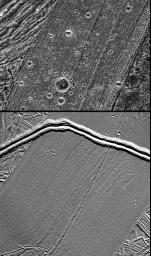This frame compares a high-resolution view of Arbela Sulcus on Jupiter's moon Ganymede (top) with the gray band Thynia Linea on another Jovian moon, Europa (bottom), shown to the same scale. Both images are from NASA's Galileo spacecraft.
Arbela Sulcus is one of the smoothest lanes of bright terrain identified on Ganymede, but subtle striations are apparent here along its length. This section of Arbela contrasts markedly from highly fractured terrain to its west and dark terrain to its east.
On Europa, gray bands such as Thynia Linea have formed by tectonic crustal spreading and renewal. Such bands have sliced through and completely separated pre-existing features in the surrounding bright, ridged plains. The younger prominent double ridge Delphi Flexus cuts across Thynia Linea. The scarcity of craters on Europa attests to the relative youth of its surface compared to Ganymede's.
Unusual for Ganymede, it is possible that Arbela Sulcus has formed by complete separation of Ganymede's icy crust, like bands on Europa. Tests of this idea come from detailed comparisons of their internal shapes and the relationships to the surrounding structures.
In the Ganymede image, north is to the top of the picture and the Sun illuminates the surface from the west. The image, centered at -15degrees latitude and 347 degrees longitude, covers an area approximately 34 by 26 kilometers (21 by 16 miles). The resolution is 34 meters (112 feet) per picture element. The image was taken on May 20, 2000, at a range of 3,370 kilometers (2,094 miles).
In the Europa image, north is to the upper-right of the picture and the Sun illuminates the surface from the northwest. The image, centered at-66 degrees latitude and 161 degrees longitude, covers an area approximately 44 by 46 kilometers (27 by 29 miles). The resolution is 45 meters (147 feet) per picture element. The image was taken on September 26, 1998, at a range of 3,817 kilometers (2,371 miles).
This image and other images and data received from Galileo are posted on the Galileo mission home page at http://www.jpl.nasa.gov/galileo. Background information and educational context for the images can be found at http://www.jpl.nasa.gov/galileo/sepo
The Jet Propulsion Laboratory, a division of the California Institute of Technology in Pasadena, manages the Galileo mission for NASA's Office of Space Science, Washington, D.C.
This image was produced by DLR (German Aerospace Center), Berlin, and Brown University, Providence, R.I., http://solarsystem.dlr.de/ andhttp://www.planetary.brown.edu/.

 Planetary Data System
Planetary Data System












